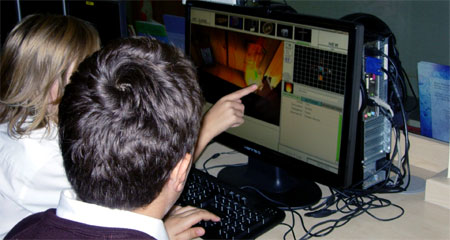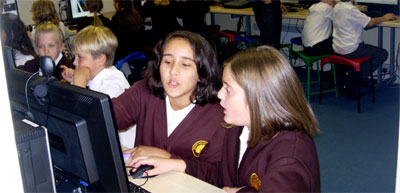Communication 21 Session 5
Session 5 focused on other games and how text is used in these. We definitely need additional lesson time. Making the games is a great stimulus for writing but less than an hour every other week just isn’t long enough. If I did this again, I’d kick of the project with a half or full day allowing the pupils to get to grips with the software.
The plan for this session5_0 Plan_Session Five
The sheets 5_1 Using Media in your Game
Communication 21 (Reflection 4)
The students in the first group were brilliant, focused and enthusiastic. Most of the students in this group grasped the rule systems and were able to extend their skills to solve problems. The second group were much slower to settle and because they lacked concentration found the same tasks much more difficult. We will need to address this before they move on.
Communication 21 Session 4
The fourth lesson plan and associated worksheets are attached. This week we focus very much on making the game: revising what they’d already done and then using the skills learned to solve other problems. As before, students are required to follow both written and verbal instructions. The homework is to analyse some of the language used in commercial games before writing their own instructions and pop-ups.
Communication 21 (Reflection 3)
The students were brilliant, focused and enthusiastic. We still tried to pack in too much, but got through most of the session without rushing too much. Most of the students grasped the rule systems. Object clicked was straightforward for everyone. The multi-step rules took some explaining, but the students who grasped the concept helped those who struggled. We’ll recap learning and test what they remember at the beginning of the next session.
Communication 21 Session 3
The third lesson plan and associated worksheets are attached. You’ll notice that I’ve reduced what we do considerably. Although the lessons should be 1 hour in length, by the time the children are collected and arrive, we’re down to about 50 minutes. This week we’re getting to grips with the rule system and the three main triggers. The literacy work is much less apparent, although students are required to follow both written and verbal instructions. They will write a log reflecting on their experiences for homework.
Communication 21 (Reflection 2)
Reflection on Session 2
An hour a fortnight really isn’t enough and it’s a shame I can’t work in collaboration with the class teacher to extend the focus on the literacy tasks. When planning I need to include half as much, but that’s going to make the focus on improving writing difficult. During the next couple of weeks we’ll focus on game-making and come back to writing once they have the start of a game.
With so little time for planning, cross curricular projects can be tough to organise in schools and, therefore, teachers aren’t used to working together. This has become more of an issue as the primary day becomes more fragmented with specialist teachers teaching separate lessons. This seems a retrograde step. Whereas secondary schools could have learnt from the primary set-up, the opposite has happened. We lose at least ten minutes of the hour lesson waiting for students to arrive and then clearing up.
The size of the two classes is also an issue. Oh for the much smaller classes of private schools! The more time I spend in state schools, the more I admire the patience, tenacity and organisational skills of the teachers.
Having said all this, the children are really enjoying the experience and pestering Peter to work on the games at lunchtime. Many have also downloaded the software and are working on it at home.
Communication 21 Session 2
Session 2
The second lesson plan and associated worksheets are attached. As before, I will modify them following the lessons to reflect what I have learned. This week the students will be responding to a simple brief in order to focus clearly on the audience for their game and what might be appropriate (touching briefly on e-safety). The focus for their writing will be a questionnaire that allows them to find out more about the intended audience. They will also look at the constraints of the tool, that is, what is possible given the resources they have.
Communication 21 (Reflection 1)
Reflection on Session 1
I think, as an ex-secondary teacher, I over-estimated the level that bright year 6 students would be at. I’m not sure what I see as level 5/6 work is necessarily the same as it was when I was teaching. Consequently, I’ve added a scaffold to support students who would struggle with the homework. See attached. I will also modify the model letter. Revised version attached too.
We also need to include some more games suitable for primary pupils to the downloads section of our website. We originally aimed the product at secondary schools, but increasingly primary teachers are expressing an interest in game-making. If you have any MissionMaker games that you have made, that don’t contain guns and would be suitable for younger students to play, please will you share them?
I desperately need some class lists and examples of SATs papers so that I can see just what will be expected of the students in May. I’m finding the uncertainty regarding curriculum guidance, slightly perplexing. It’s quite tough tracking down the literacy APPs some of which seem to be archived, some to have disappeared and all rather difficult to download and use. One wonders how relevant they are, but with schools still using them, I need to fall into line! No wonder teachers are so stressed.
Communication 21
Improving primary literacy through making games
Over the next two terms I’m working with year 6 students at Burnt Oak primary school to explore how making games in ICT lessons can contribute to improving literacy, particularly with reluctant writers, usually boys. The focus is transactional writing as the two groups prepare for SATs, but we will also look at the project’s potential to stimulate creative writing. We are using MissionMaker to make the games and Kar2ouche to communicate the process and capture some of the written output. Students will also keep a log summarising what they do and learn. Over the ten weeks (one lesson per fortnight) I will post the lesson plans followed by a reflection on the success of the session, supported by samples from the student logs and examples of the products submitted for marking and my comments. Please feel free to use the materials and to contribute to the reflective process.
Session 1
The first lesson plan and associated worksheets are attached. I will modify them following the lessons to reflect what I have learned by working with students of this age. Basically we are playing games that others have made in order to become familiar both with the navigation and the types of games that can be created using the software. By writing a review of one of the games played, the students are beginning to think about what makes a good game.
The project was the idea of the schools ICT coordinator Peter Barrett
Welcome to our New Blog!
Welcome to our new blog! If you don’t know anything about us, we’re the developers and resellers of Kar2ouche, MissionMaker, MediaStage and Krucible. We’ve been around just over ten years and work almost exclusively with schools. The company is run by two ex teachers …


